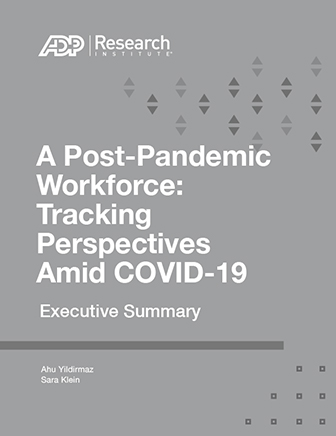A Post-Pandemic Workforce: Tracking Perspectives Amid COVID-19 | 2020
Executive Summary
Summary of tracking workforce perspectives amid Covid-19:
June 01, 2020
|

Recent job loss figures paint a bleak picture of how COVID-19 has disrupted the American workforce. ADP Research Institute® (ADPRI) has conducted a survey to take a detailed look at how workers in the United States have been affected during the first eight weeks of the global pandemic. The survey reveals the workplace has shown resilience in managing challenges and adapting to the new ways of working.
Key Insights:
• A Seismic Shift: The COVID-19 national health emergency forced immediate changes to the workforce. Workplaces closed for about one in four workers, which for some coincided with job loss. For many of those who were able to continue working, the workplace was very different than just a few weeks before, as employers set and revised new rules about where work could be done. In the first week of the national emergency, 17% of workers were required to work from home, with this number leaping to more than one in four in just the second week of the pandemic crisis.
• A Real Trend Toward Telework: The percentage of workers doing telework every day increased from 28% in Week 1 to 44% in Week 2 and remained completely unchanged for the next six weeks. The increase in the frequency of employees exclusively working from home appears to have been driven by those who could not do so before the crisis.
• The “New Normal”: In the first few weeks of the crisis, stress levels were high as workers struggled with childcare constraints, fear of the virus, technical issues and trouble completing their tasks. Beginning in Weeks 3 and 4, many of these issues became less likely to impact their work. Though elements like stress, work-life balance, the ability to connect with others and the ability to complete tasks did not get better, they became less likely to get worse each week.
• Productivity Impacted: Despite adapting to newfound circumstances, productivity does not appear to have recovered to pre-pandemic levels. Working hours, the frequency of communication with others and the ability to complete tasks declined quickly and did not bounce back for most. Employees reported that their key obstacles were technical difficulties, including internet connectivity and insufficient equipment, and stress about the coronavirus itself. Fear of the virus trended downward over the weeks, though technical difficulties did not.
• Financial Impact Widespread: The personal financial impact of the pandemic extended even beyond those who experienced job loss. Sixty-two percent of those who had retained their jobs reported that the pandemic has had a negative impact on their personal finances, or they expect it will soon. However, the majority were optimistic that their finances would return to previous levels in less than six months.
• Job Confidence Increasing: Employees were least confident in their ability to retain their jobs in the third week of the survey, which coincided with record unemployment figures. Still, possibly buoyed by headlines of stock market successes, the Payroll Protection Program and local business reopenings, the last two weeks of the survey saw an increase in confidence, with nearly 70% of workers expecting they would retain their job for at least the next month. For those who had lost their jobs, about one in three were expecting to return to their jobs within the month.
• Employer Response Matters: Most employees say their employer took action in response to the pandemic crisis, but certain things felt more impactful to employees than others. Sharing positive messages, facilitating work from home and encouraging virtual connections appeared most likely to lead to satisfied employees. And those who reported being most satisfied were likely to say they were even more interested in staying with their current employer than they were before the coronavirus outbreak.

Get the Executive Summary







